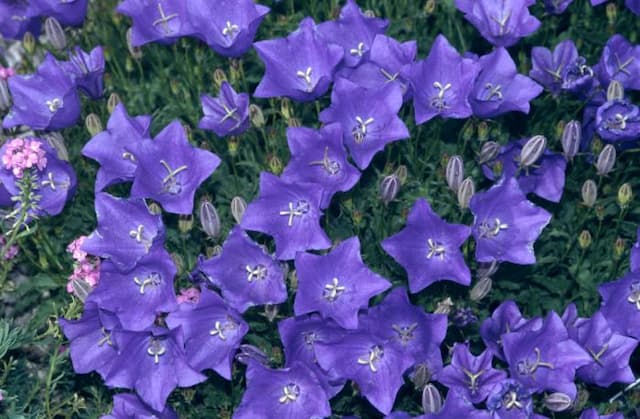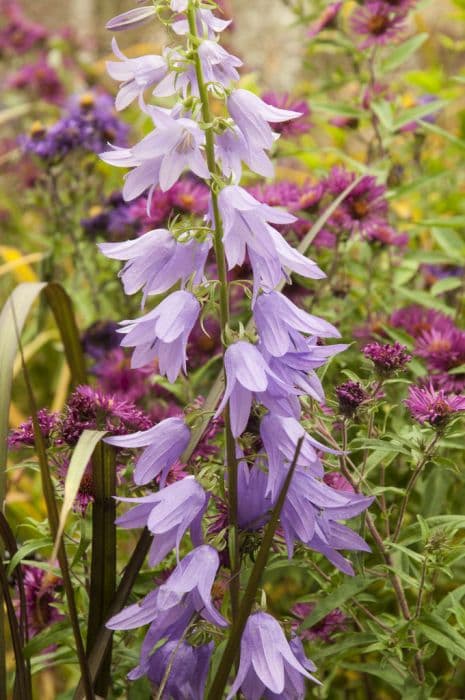Serbian Bellflower Campanula poscharskyana

ABOUT
The plant commonly known as Serbian bellflower showcases an enchanting display of small, star-shaped flowers that cover its foliage from late spring to early autumn. These delicate blooms appear in a mesmerizing shade of blue, often characterized as lavender or light purplish-blue. Each flower consists of five pointed lobes that spread outwards, creating the star-like silhouette that is a hallmark of the Serbian bellflower's charm. The foliage of the Serbian bellflower is a lush green, forming a dense and mounded groundcover. The leaves are heart-shaped, sometimes displaying a rounded or slightly toothed edge. They are typically soft to the touch with a slight fuzziness on the surface, creating a quilted texture that adds to the plant's visual appeal. Through its blooming season, the Serbian bellflower is a reliable source of vibrant color and can often be seen spilling gracefully over rocks, walls, or the edges of containers, lending a romantic and whimsical aspect to gardens and landscapes where it thrives.
About this plant
 Names
NamesFamily
Campanulaceae
Synonyms
Serbian Bellflower, Trailing Bellflower, Poscharsky Bellflower, Blue Waterfall
Common names
Campanula poscharskyana_var._alba, Campanula poscharskyana_var._stricta, Symphyandra poscharskyana.
 Toxicity
ToxicityTo humans
The plant commonly known as Serbian bellflower, is generally considered non-toxic to humans. There are no well-documented cases of poisoning from ingesting this plant.
To pets
The Serbian bellflower is considered non-toxic to pets, including cats and dogs. Ingestion of this plant should not cause any significant symptoms of poisoning or serious health issues. However, it is always prudent to monitor pets for any unusual reactions if they consume plants.
 Characteristics
CharacteristicsLife cycle
Perennials
Foliage type
Semi-deciduous
Color of leaves
Green
Flower color
Blue
Height
0.5 feet (15 cm)
Spread
2 feet (60 cm)
Plant type
Herb
Hardiness zones
3
Native area
Balkans
Benefits
 General Benefits
General Benefits- Ground Cover: Campanula poscharskyana, commonly known as Serbian bellflower, acts as an excellent ground cover, filling in spaces and helping to suppress weeds.
- Aesthetic Appeal: With its star-shaped blue flowers, it adds beauty and a splash of color to gardens and landscapes.
- Attracts Pollinators: The flowers are known to attract bees, butterflies, and other beneficial insects, supporting local ecosystems.
- Drought Tolerance: Once established, the Serbian bellflower is quite drought-tolerant, making it suitable for xeriscaping or areas with low water availability.
- Low Maintenance: It requires minimal care once established, making it a good choice for gardeners looking for low-maintenance plants.
- Fast Growth: Serbian bellflower spreads quickly, providing a rapid filling in of garden spaces or bare spots.
- Rock Gardens: Ideal for use in rock gardens due to its ability to grow in rocky, less fertile soil and its cascading growth habit.
- Seasonal Interest: It blooms from late spring to early autumn, providing long-lasting visual interest throughout the growing season.
- Soil Adaptability: Capable of growing in a range of soil types, although it prefers well-draining soil.
- Edging Plant: Its mounding growth habit makes it suitable for edging paths and garden borders.
 Medical Properties
Medical PropertiesThis plant is not used for medical purposes.
 Air-purifying Qualities
Air-purifying QualitiesThis plant is not specifically known for air purifying qualities.
 Other Uses
Other Uses- Alpine Gardens: Campanula poscharskyana, commonly known as trailing bellflower, is often used to create a flow of color and interest in rocky alpine gardens, where its cascading growth habit mimics the natural flow of water.
- Fairy Gardens: Due to its petite size and enchanting look, trailing bellflower can be incorporated into fairy gardens to create a whimsical landscape suitable for imaginative play or decorative purposes.
- Living Mulch: The dense foliage of Campanula poscharskyana serves as a living mulch, helping to suppress weeds and retain soil moisture in garden beds.
- Ornamental Edging: The trailing bellflower can be planted along the edges of walkways or borders, where its flowering trails provide a soft, ornamental edge to hardscaped areas.
- Photography: The intricate flowers and trailing habit of Campanula poscharskyana make it a popular subject for garden photography, highlighting the beauty and complexity of nature.
- Ground Cover: In larger landscape designs, trailing bellflower can act as a ground cover, providing a blanket of greenery that requires little maintenance once established.
- Hanging Baskets: Campanula poscharskyana is suitable for hanging baskets, creating a cascade of flowers that can add vertical interest to patios, porches, or balconies.
- Rock Wall Filler: As a versatile plant, trailing bellflower can fill the nooks and crannies in rock walls, softening hard stone features with its foliage and blooms.
- Erosion Control: The mat-forming nature of Campanula poscharskyana helps stabilize soil on slopes and banks, reducing the risk of erosion and landscape damage.
- Butterfly Gardens: The nectar-rich flowers of the trailing bellflower attract butterflies and other pollinators, making it an ideal addition to butterfly gardens and biodiversity-friendly landscapes.
Interesting Facts
 Feng Shui
Feng ShuiThe plant_name is not used in Feng Shui practice.
 Plant Symbolism
Plant Symbolism- Constancy and Perseverance: Campanula poscharskyana, commonly known as the Serbian bellflower, typically signifies constancy and perseverance due to its ability to spread and flourish in many environments.
- Gratitude: As part of the campanula, or bellflower, family, Serbian bellflowers are often associated with gratitude, and giving them can be a way to express thankfulness.
- Vulnerability: The delicate nature of the bell-shaped flowers can symbolize vulnerability and the need to handle relationships with care.
- Youthful Energy: The Serbian bellflower, with its starry flowers and rapid growth, can also represent the youthful joy and energy of its exuberant blooms.
- Connection to Nature: The plant's vigorous nature and tendency to grow in rocky areas can also indicate a strong connection to the natural world and the cycles of life.
 Water
WaterThe Serbian bellflower, also known as Campanula poscharskyana, prefers evenly moist soil, so it's important to water it thoroughly whenever the top inch of soil feels dry to the touch. This could mean watering approximately every 5 to 7 days, depending on climate conditions. Care should be taken not to overwater, as this can lead to root rot. Each watering session should involve providing enough water to soak the soil around the roots without leaving the plant standing in water. As a guideline, use about half a gallon of water per plant each week, adjusting for temperature, humidity, and the plant's growth stage.
 Light
LightSerbian bellflowers thrive in full to partial sunlight, which translates to at least six hours of direct sunlight daily. They do well in a spot that receives morning sunlight and dappled shade in the afternoon, particularly in hot climates. Avoid deep shade, as it can hinder the plant's growth and reduce flowering.
 Temperature
TemperatureSerbian bellflowers are hardy and can tolerate a wide range of temperatures. They can survive minimum temperatures down to around 20°F but grow best when the temperature is between 60°F and 75°F. They should be protected from extreme cold and can manage well in heat as long as they are not in constant high temperatures over 85°F for prolonged periods.
 Pruning
PruningSerbian bellflowers benefit from occasional pruning to maintain shape and encourage bushier growth with more blooms. Deadheading spent flowers can promote a second bloom. The best time for major pruning is in early spring or after the main flowering period has finished. Pruning up to once or twice a year is typically sufficient.
 Cleaning
CleaningAs needed
 Soil
SoilThe Serbian Bellflower thrives in well-draining soil with a mix of compost, loam, and sand which ensures proper drainage. It prefers slightly alkaline to neutral pH, ranging from 6.5 to 7.5.
 Repotting
RepottingSerbian Bellflowers should be repotted every 2-3 years to refresh the soil and provide room for growth. It's best to repot in the spring.
 Humidity & Misting
Humidity & MistingSerbian Bellflower tolerates a wide range of humidity levels but prefers average household humidity, making them versatile for most indoor environments.
 Suitable locations
Suitable locationsIndoor
Place in bright indirect light and keep soil moist.
Outdoor
Plant in partial shade to full sun in moist soil.
Hardiness zone
3-8 USDA
 Life cycle
Life cycleCampanula poscharskyana, commonly known as Serbian bellflower, begins its life cycle as a seed, which, upon germination in early spring, develops a small root system and shoots. This perennial plant progresses to the vegetative stage, forming a low, spreading mound of foliage with heart-shaped, tooth-edged leaves. As it matures into the flowering stage during late spring to early summer, it produces star-shaped, blue to lavender flowers on trailing stems that can bloom for several weeks. After pollination, typically by bees and other insects attracted by the flowers, the plant produces small, capsule-like fruits that release seeds, completing the reproductive cycle. In winter, the Serbian bellflower may die back, especially in colder climates, but its root system remains alive underground, enabling it to regrow and reenter the vegetative stage the following spring. With adequate growing conditions, the plant can spread and form a ground cover through both reseeding and vegetative propagation from sprawling stems that root at the nodes.
 Propogation
PropogationPropogation time
Spring to early summer
Propogation: Campanula poscharskyana, commonly known as the Serbian bellflower, is often propagated through division, which is the most popular method. The best time to propagate by division is in spring when the plant is emerging from dormancy or in early fall when the temperatures are cooler but the soil is still warm. The process involves gently lifting the plant from the ground with a garden fork and separating the clumps into smaller sections, ensuring that each division has a portion of the root system and several shoots. Replant the divisions immediately at the same depth they were previously growing and water them thoroughly. This method allows for quick establishment and flowering often occurs within the same season.









